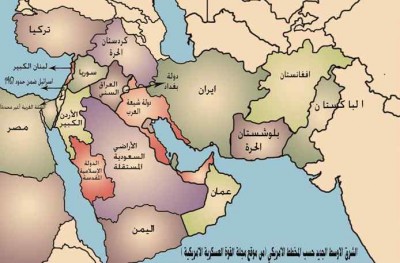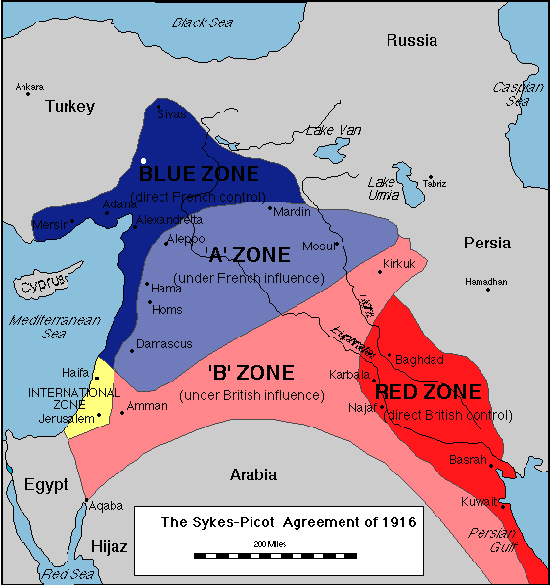
100 years ago today, Britain and France carved up Syria, Iraq and Israel. Their imperial mindset still scars the region.
One hundred years ago today, Britain and France drew a line through the Middle East that became the border between Syria and Iraq, with a kink at the end of it that became Israel. You get a sense of the breezy confidence behind the so-called Sykes-Picot agreement from the minutes of the cabinet where the idea was hatched:
“What sort of agreement would you like to have with the French?” Arthur Balfour, the Foreign Secretary, asks Sir Mark Sykes – a brilliant but erratic colonel just back from a tour of the region. “I should like to draw a line from the ‘e’ in Acre to the last ‘k’ in Kirkuk,” says Sykes.
Thus the destiny of millions of people was shaped by the way a printer had arranged some place names on a map.
It was not the first unfortunate encounter Sykes had with a map. In January 1915, he penned a fateful letter to Winston Churchill urging him to seize Constantinople (now Istanbul).
Sykes pointed out that if Britain and France could seize the main city of the Ottoman Empire, not only would that empire crash, and German influence in the east be ended, but the way might be open to invade Germany via the Balkans.
“Could you by June be fighting towards Vienna,” Sykes advised, “you would have got your knife near the monster’s vitals and perhaps might achieve the line Mulhausen, Munich, Vienna, Cracow before winter”.
It is worth contemplating this line – Sykes was very keen on lines – with your finger. To get there, Britain would have had to subjugate the entire Balkan region. To kick things off, you had to land troops in Turkey, at a place called Gallipoli.
“It is not so chimerical as it may sound,” Sykes wrote to Churchill. 40,000 troops died trying to prove him right, but failed.
When Islamic State blew up border posts between Iraq and Syria in 2014, it declared an “end to the Sykes-Picot era”. But you do not have to be a terrorist to object to the imperial mindset that drove the agreement.
The arbitrary drawing of borders, in defiance of geography, ethnicity and common sense, became the hallmark of imperialism in the nineteenth and early twentieth centuries.
If, today, the Kurds are driving IS out of northern Syria, with bare-headed communist women in the vanguard, that is – in part – a result of Sykes legacy. In 1915, Sykes assured the British cabinet that “east of the Tigris the Kurds are pro-Arab”. Kurdistan was subsumed within a French zone of control and, by the time the post-war order was frozen at Versailles in 1919, the Kurds had become a non-people.
Sykes’ famous pencil-stroke through the Arab world, combined with his enthusiastic support of Balfour’s 1917 declaration in favour of a Jewish state in Palestine, makes him one of the few British figures who exerted strategic influence on the twentieth century.
It was influence born of first-hand knowledge and experience. Sykes had grown up in the Arab world. His assurance to Prime Minister Herbert Asquith that the “spiritual fire” of pan-Arabism lay in Saudi Arabia, while its “intellectual organising power” lay in Syria, Palestine and Beirut was well-observed.
But his expertise prompts the question: how could somebody so knowledgeable get it so wrong?
To read Sykes’ papers today is to observe the tragedy of an intellect shackled by delusions of superiority. Sykes worked on the assumption, central to all imperialisms: that subject peoples behave only according to their ethnic or national “characteristics”, whereas powerful white nations have agency.
Paradoxically, for someone whose name was hated by generations of Arabs, Sykes idolised Arab culture. First because he believed it to be non-revolutionary, in contrast with nationalism in Turkey and India where the problem was “a lot of poor men who have got a little education and greater ambitions”.
Second, because he believed it could encompass both wings of Islam, plus Christianity, and tolerate the Jews.
The one national characteristic Sykes and his generation never seemed to notice was their own. Imperialism turned them into purblind fools who thought that, by drawing lines, they could control history.
What they failed to imagine was that, first, Turkey would develop a modern, secular, national consciousness. This meant their one-way bet against the Ottoman Empire during the First World War proved futile. Turkish secular nationalism would shape the region just as much as pan-Arabism in the next 100 years.
Second, though he understood Islam well, Sykes and his generation saw it as entirely secondary to ethnicity, language and political tradition.
Third, they failed to anticipate the emergence of anti-imperialism: once “very poor men” got educated, and were drawn into cities and factories, it was they who began shaping history and the white officer class who had to stand and watch.
Fourth, they failed to imagine that, one year after Sykes-Picot, a workers’ revolution in Russia, spreading to the Caucasus, would free large parts of the exotic and remote world they had become obsessed with – not just from imperialism but from capitalism itself.
Today, the easy lesson to learn from Sykes-Picot: don’t draw arbitrary lines across the map. Peoples and nations must have the right to self-determination. This was the principle US President Woodrow Wilson outlined as America entered the war, and which caused the British and French governments to hide the existence of Sykes’ map from Washington.
The harder lesson to learn is: never rely on national stereotypes; never reduce the conflicts of the world to ethnicity alone. There are also class, gender, religion, politics and history – attributes Sykes discounted as he tried to predict how the sub-groups of the Middle East would react to British policy.
The final lessons is: accept responsibility. The Sykes-Picot agreement was conceived in the same room David Cameron’s cabinet sits in now. The passage of time should not absolve us from engaging with the situations we messed up.
